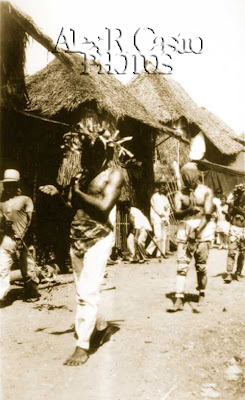 THE WAY OF THE CROSS. A flagellant or magdarame makes his way through the streets while enacting the Lord’s passion, often with blood and gore, as an act of penance or panata. Flagellant processions began in Europe, spread to Spain and reached our shores in the 17th century. Circa 1915-1920.
THE WAY OF THE CROSS. A flagellant or magdarame makes his way through the streets while enacting the Lord’s passion, often with blood and gore, as an act of penance or panata. Flagellant processions began in Europe, spread to Spain and reached our shores in the 17th century. Circa 1915-1920.“Nung ing Ginu lalasa ya’t mamagdusa,
karampatang mung damayan de’t abaran ding sasakupan na..”
The earliest documented flagellant processions in Europe occurred in Italy around 1260-1261. These were believed to be associated with the intensely dramatic sermons of the Franciscan preacher from Perugia, Fra Rainerio Frasani. Flagellant movements spread throughout Europe in the 14th century, and processions were observed in France, Germany, Austria and the Low Countries. During the medieval period, these processions were timed directly with periods of social stress, such as plagues, drought and war.
Flagellant practices appeared rather late in Spain, but acts of mortification and self-flogging were known even before the extensive European flagellant movements. As early as the 4th century, the Bishop of Barcelona, San Paciano (d.392), advocated public self-mortification as a form of penance. Flagellations, more often than not, were meted out by the Church as punishments, preferably during Semana Santa, as specified in the Liber Ordinum.
Spontaneous flagellant processions first were practiced in Catalonia, fired by the sermons of San Vicente Ferrer (1350-1419), a Dominican priest that had an early following in the Philippines. Barefoot penitents wore masks (antifaz), hoods and sack cloth tunicas which were open in the back to permit whipping. The “mano de rodezuela”, a spiked short wooden or hemp-handled whip was capable of drawing copious quantities of blood from the body, thus providing quite a visceral spectacle for onlookers.
Organized flagellant brotherhoods regularized the practice in Europe and when Spain expanded its frontiers to include Latin America and the Pacific, its missionaries introduced the practice to Filipinos, who readily embraced the bloody ritual as part of the new religion and as a way of purification as early as the 17th century.
The ways of the “magdarame” have always inspired awe and curiosity amongst the faithful during the days of Lent. Bloodied, scourged and caked with dust, magdarames live and act out the passion of the Lord—and the term “dame”, to sympathize and share one’s grief-- captures this spirit of Oneness, in pain and sorrow.
The practice of “darame” in Pampanga was popularized by casamacs or peasants, who regard sacrifices such as fasting, prayer or abstinence as too mild. Among these materially deprived workers, only the extreme imitation of the Passion under the searing heat of the sun can cleanse them of their evil. It was further institutionalized during the American era prompted by our colonizer’s curiosity for exotic folk practices. The practice of actual crucifixion was introduced in San Fernando only in the 1950s.
Over the course of the centuries, the rituals of the magdarame’s penitencia has not changed. To prepare himself, the magdarame whips his back until it swells. Then, it is incised with a panabad, a paddle with shards of broken glass or directly with a razor. To draw blood, he flogs himself with burilyos, short bamboo strips tied to a cloth. This type of magdarame—mamalaspas—then makes the rounds of visitas, with face covered with a black hood (capariza) and crowned with twisted branches or leaves.
Another kind is the sasalibatbat, who fling their bodies to the ground, rolling over sharp rocks and stones in the process. Their torsos, legs and arms are tied with abaca rope to impair circulation, hence making the experience more torturous. Mamusan krus, on the other hand, carry crosses on their shoulders or are strapped to the cross itself with arms roped at both ends. The walk around town begins in the morning, ends by early afternoon and is followed by a dash to the nearest river for a quick, recuperative bath.
Behind all these rituals is a personal vow or panata. The magdarame often endures the painful sacrifice in exchange for help for a pressing problem like finding a cure for an ailing relative or even as mundane as passing the board exams. Bloody, gory and morbid as it may seem, the practice of darame continue to persist in Pampanga, a penitent’s direct response to Jesus’ challenge to come and take His Cross, lending support to the claim—no pain, no gain.
(8 April 2003)








No comments:
Post a Comment